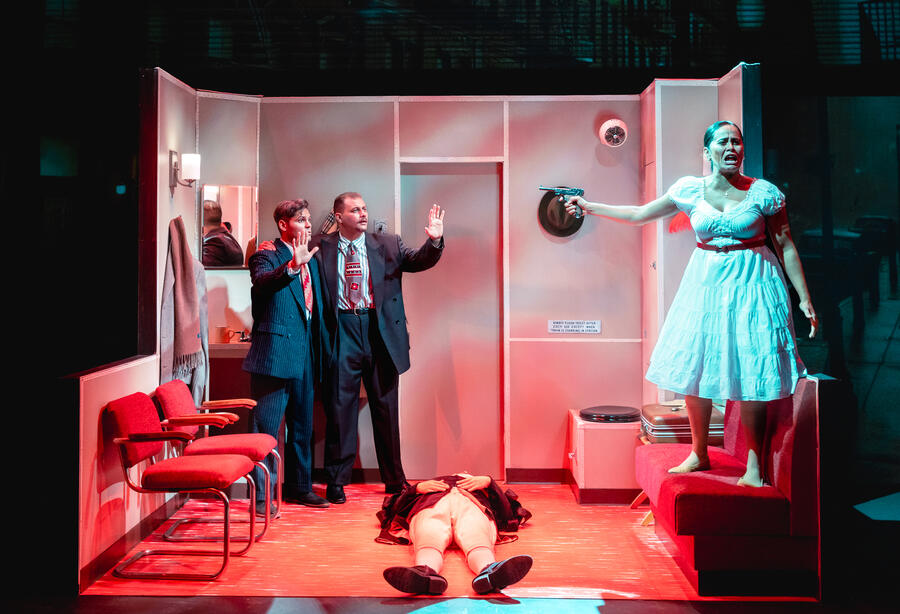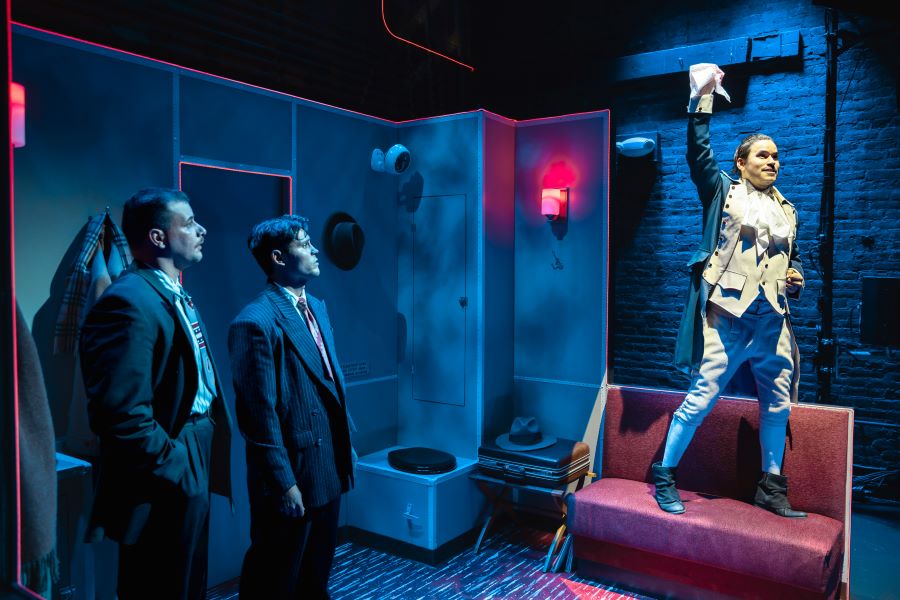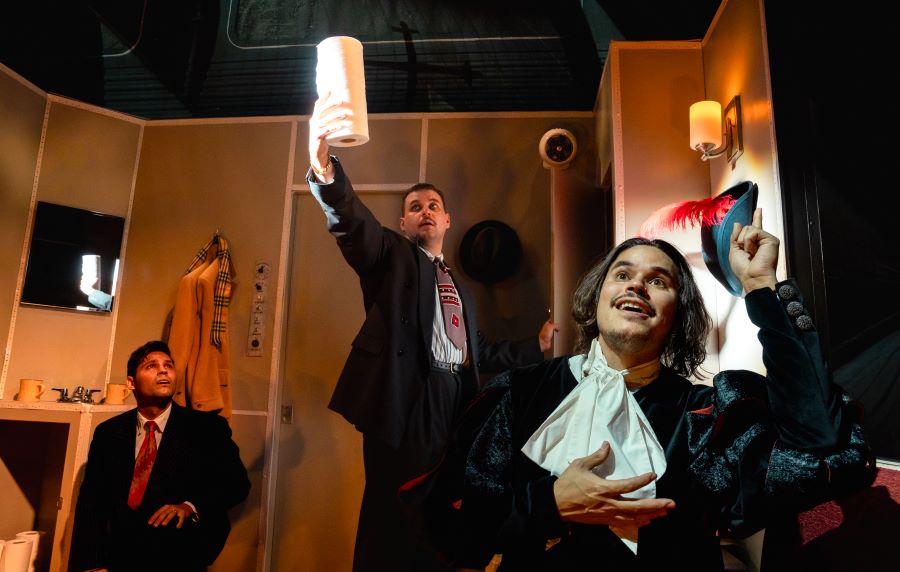“Cuando a sus playas llegó Colón / Exclamó lleno de admiración / Oh! Oh! Oh! Esta es la linda tierra que busco yo.” (“When at her beaches arrived Christopher Columbus / He exclaimed, full of admiration / Oh! Oh! Oh! This is the beautiful land I seek.”)
So goes “La Borinqueña,” the “official,” and historically embattled, national anthem of Puerto Rico. On a below-freezing December night in Manhattan, when Gris—a lead character in Matthew Barbot’s new play about the two Puerto Rican nationalists who plotted to assassinate President Harry Truman in 1950—begins to sing these lyrics, a woman seated in front of me in the audience sings along on impulse. I hear a smattering of others joining in from their respective seats in the historic home of Pregones/Puerto Rican Traveling Theatre on 47th Street.
As the singing dies down, Christopher Columbus, another character in Barbot’s play, based on the real-life colonizer, asks, “What’s that?”
Replies Gris, based on the real-life Griselio Torresola: “It’s a song we have.”
Columbus proudly exclaims, “And I’m in it?…I really left a mark.”
“A scar,” quips Oscar, based on Torresola’s co-conspirator in the Truman assassination plot, Oscar Collazo.
This is where Barbot’s the beautiful land i seek (la linda tierra que busco yo), which opened last week at Pregones/PRTT, gets its name. It’s a play about, and born of, scars: the history that makes them, the ways they persist, and the people who aim to avenge them. The play takes place in a single compartment of a magic train on which Gris (Bobby Román) and Oscar (Alejandro Hernández) travel to Washington, D.C., with the intent to kill President Truman in the name of Puerto Rican independence. On their journey, they encounter figures from the past, present, and future, who lead them to question the meaning and impact of their planned action. The beautiful land i seek is wonderfully discombobulating, blurring the lines between past and present, imagination and reality, form and content. In pulling from, and pulling apart, an array of genres and artistic inspirations, the play defies neat categorization.

Barbot began the first draft in 2020. The Covid-19 pandemic was in full swing. Puerto Rico was still recovering from the devastation of hurricane Maria, for which the U.S. government provided insufficient aid. When the island territory was hit hard by the pandemic, again the U.S. government failed to provide substantial aid. These were the political and economic conditions under which Barbot’s own grandmother had to leave her homeland of Puerto Rico for the U.S., where she ultimately died.
Meanwhile Hamilton became available for streaming. Reggaeton was flooding the “mainstream.” Steven Spielberg was remaking West Side Story. In The Heights was getting a movie adaptation. (Barbot notes his different opinions of these two musicals: He loves In The Heights, while his feelings about West Side Story are reasonably “complicated.”) Barbot was deeply “upset” personally, politically, artistically. And it all felt loosely related.
All of this context shows up in the play. There’s an outlandishly distressed Maria à la West Side Story, weeping over the (spoiler alert) dead body of Christopher Columbus (Gris shoots him), before dragging his body offstage in humiliation after it is revealed that her skin has been painted brown. (She comes back later, though, changed, wiping the paint from her face and lucidly condemning the “heavy, dead, alien” way her love pronounces her name.) There’s a recognizably revisionist Alexander Hamilton, rapping and dancing gratingly. (“I didn’t know any of the founding fathers were so brown,” says Gris. “Some have theorized that Hamilton was of mixed background,” answers Oscar. “Does this change anything?” Gris asks. Oscar replies, “I don’t know.”)
The play bursts with all it contains, from fictional characters to imagined versions of historical figures, references old and new. Barbot even writes himself, with a twinge of self-deprecation, into a character he calls the Writer, who treats Gris and Oscar as minable “resources” for his play.

“What is the position of a storyteller taking on the responsibility of stewarding a historical event?” Barbot wondered in an interview. “Where I land, ultimately, is that it is about me. It’s about me and my concerns. Everything else is set dressing. My impulse in the writing was that I should contend with myself as part of this long story.”
Barbot had long been interested in what he describes as the “forgotten story” of Torresola and Collazo, the two Puerto Rican would-be assassins of Truman. But it wasn’t until the combined personal and political grief of losing his grandmother during the charged period marked by the ruin of the hurricane and the pandemic that Barbot’s ideas about Gris and Oscar came unstuck from the back of his brain and onto the pages of a script.
“I realized that this is a play about me being upset about the response to Maria,” he said of the hurricane. “This is a play about my grandmother having to move here because she wasn’t able to take care of herself on the island. This is a play about everything I’ve read about history, not just these two men in the ’50s. Suddenly all this stuff felt very personal to me, these political things, this history, these things I’d been watching on the news for a couple of years. That’s where the play came from.”
Once that became clear, he wrote straight through, not stopping to reread a single line until after he had typed the words “end of play.”
“I decided that I was just going to trust every impulse and not ask questions about it until the end,’” Barbot said. “If I think too much about it, I’m going to spiral in the first 20 pages of it. What I actually need to do is just get to the end and then see what I’m left with.”
That turned out to be the first draft of the beautiful land i seek, which he developed first in a 2022 reading and later, in a staged development process with Fault Line Theatre, before it hit the stage at Pregones/PRTT this month (in a co-production with Fault Line and LatinX Playwrights Circle). Director José Zayas, with whom Barbot has worked on several new plays in an 11-year creative partnership, has been with the play since the first reading at Fault Line. The cast has also remained mostly the same from that first reading to the Pregones/PRTT world premiere.
“I think as you’re working through [the play], you figure out the sense that it’s making and the logic of it,” Barbot told me. “It’s just trusting a little in the stuff that comes forward from your imagination.”
This “write first, make sense of it later” approach is delightfully evident in the production at Pregones/PRTT. It feels deliciously impulsive and indulgent. You can never quite tell where it’s going, which figure—real or imagined, past or future—will show up in the train compartment next, and what chain of reactions they might set off. There are no limits to what Barbot imagines in his writing, and in turn, what the production sets out to make real.

Barbot said the rehearsal process was one of exploration and discovery. After years of working together in development, the actors and creative team have brought their own artistry, openness, and vulnerability to the rehearsal room.
“Every time we come back to it, we’re different people,” Barbot said. “So much is different in the world each time. These artistic families come together and dissolve over and over again in theatre so often, so having this crew for this script has come to mean a lot.”
His collaboration with Zayas was especially fruitful in the rewriting process, which, when I talked to Barbot early in previews, was still underway.
“José is very good at putting pressure on elements and asking, what does this mean, do we need it, and why is it there?” Barbot explained. “It’s in the tension between my wanting to keep something and his wanting to cut something, for example, that I figure out what the essential bit of it is.”
Drilling such a limitless play down to the essentials strikes me as no small undertaking. Taking the play from his brain, to a company of actors at music stands, to a historically accurate train compartment on the stage at Pregones/PRTT has reminded Barbot of what he loves so much about his chosen art form.
“There’s something very exciting about what theatre means for collaboration, for deepening ideas, for finding together the most funny way to do this, for being in this struggle with expression for a couple of weeks and then sharing it,” he said. “That is so exciting, and it makes the art better.”
Sharing the story with audiences has given it yet more new life. One might expect a play so vast and disparate to alienate some audiences. On the night I see it, though, the beautiful land i seek seems to have the opposite effect on those in attendance. Not only do audience members sing along with the characters to both “La Borinqueña” and poet-activist Lola Rodriguez’s popular pro-independence version of it; they also often react to the events of the play out loud. It has been a while since I’ve sat in an audience so free, so instinctually responsive. When Gris shoots Columbus, someone seated behind me loudly exclaims “FINALLY!,” triggering applause throughout the audience. All throughout there is unrestrained laughter.
“I worry it’s a cliché, but I think that laughter is a way that people deal with pain, or grieving,” Barbot told me. “The fear is always that it’s going to diminish the severity or the seriousness of what’s going on. But I think actually what it allows for is for people to come together about it. It provides a way to confront, and to know that you’re confronting it with this room full of people.”
It’s been fulfilling for Barbot to share this piece with Pregones/PRTT audiences, who come to see plays that align with the theatre’s mission to promote a “Puerto Rican/Latinx cultural legacy of universal value.” The beautiful land i seek even contains a reference to René Marqués’ La Carreta (The Oxcart), a play that marked the birth of PRTT in 1968, before it was even slated to premiere there.
“I think there’s something about community that we talk about in theatre a lot and that, for all of the positive and wonderful experiences I’ve had in theatre, I haven’t experienced in this particular way before, both between the creative process and now sharing with an audience and feeling that feedback, that recognition, that kindling,” Barbot said. “Having this Pregones/PRTT audience come to it and respond in particular ways has been really rewarding, in a way that I haven’t often had the experience of in theatre. There’s history in the bricks there.”
the beautiful land i seek is on at Pregones/PRTT through Dec. 29.
Citlali Pizarro is a writer and producer based in New York City. Her work can be read in American Theatre, Howlround, and 3Views.
Support American Theatre: a just and thriving theatre ecology begins with information for all. Please join us in this mission by joining TCG, which entitles you to copies of our quarterly print magazine and helps support a long legacy of quality nonprofit arts journalism.


